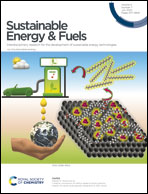Insight into sulfur-rich selenium sulfide/pyrolyzed polyacrylonitrile cathodes for Li–S batteries†
Abstract
As promising cathode materials in lithium sulfur batteries, sulfur-rich selenium sulfide (SexS1−x)/pyrolyzed polyacrylonitrile (pPAN) composites, denoted as SexS1−x@pPAN, can effectively alleviate the problem of polysulfide dissolution and deliver reliable performances. Nevertheless, the material properties essential to the electrochemical performance of SexS1−x@pPAN still require further studies. Herein, SexS1−x@pPAN materials were prepared via a simple calcination strategy using the commercial selenium sulfide (SeS2) as the sulfur and selenium source. SexS1−x@pPAN composites with different active material contents were successfully synthesized by controlling the calcination temperature, and thus the reaction kinetics of the lithium–sulfur battery could be precisely manipulated. The electrochemical performance of the as-prepared SexS1−x@pPAN materials was systematically investigated, and a temperature dependence of the specific capacity was observed. Consequently, the optimized synthetic conditions were determined, resulting in the assembled Se0.38S0.62@pPAN-450 °C full cell showing a high areal capacity of 2.62 mA h cm−2 after 200 cycles with a high Se0.38S0.62 loading of 4.53 mg cm−2 in ether electrolyte. Furthermore, Se0.38S0.62@pPAN-450 °C exhibited excellent battery performance in both carbonate and ether electrolytes.



 Please wait while we load your content...
Please wait while we load your content...